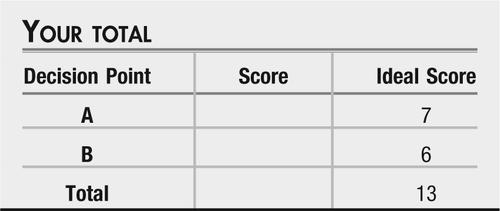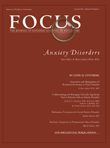Patient Management Exercise for Anxiety Disorders
Abstract
This exercise is designed to test your comprehension of material presented in this issue of FOCUS as well as your ability to evaluate, diagnose, and manage clinical problems. Answer the questions below, to the best of your ability, on the information provided, making your decisions as you would with a real-life patient.
Questions are presented at “decision points” that follow a section that gives information about the case. One or more choices may be correct for each question; make your choices on the basis of your clinical knowledge and the history provided. Read all of the options for each question before making any selections. You are given points on a graded scale for the best possible answer(s), and points are deducted for answers that would result in a poor outcome or delay your arriving at the right answer. Answers that have little or no impact receive zero points. At the end of the exercise, you will add up your points to obtain a total score.
CASE VIGNETTE
Marie is a 23-year-old woman who was referred to you from the emergency department (ED) at the local community hospital. She had come to the ED two weekends ago with a chief complaint of “freaking out” at a party with friends. After being observed and stabilized in the ED, she was referred to you for outpatient care.
The information sent from the ED stated that patient had been in her usual state of good health until that evening, when she experienced worries that she had become acutely and seriously ill. This had occurred over the course of approximately 15 minutes. She had regained her composure sufficiently to have a friend drive her to the ED, where she had endorsed complaints of tachycardia, dyspnea, diaphoresis, and lower abdominal discomfort but without diarrhea. An ECG in the ED revealed sinus tachycardia but no other abnormalities. Laboratory tests showed that her ALT and AST levels were at the top of the normal range. A urine toxicology panel performed in the ED detected no substances of abuse.
Consideration Point A:
As you review her records and the data from the ED before your initial evaluation interview, your thoughts include which of the following as likely reasons for her episode?
| A1._____ | Generalized anxiety disorder |
| A2._____ | Social anxiety disorder |
| A3._____ | Panic disorder |
| A4._____ | Substance use |
| A5._____ | Manic episode |
VIGNETTE CONTINUES
As you collected your own history and examination data, you asked Marie about whether this is the first such event in her lifetime. She explained that she has been under a great deal of stress at work, but during the event that weekend was the first time she had felt that combination of symptoms. She proceeded to report that, since that first event, she has had five other events where, similarly, she “felt like I was losing my mind,” along with racing heartbeat, shaking hands, excessive sweating, and abdominal distress. She offered that the Saturday evening event was not precipitated by being observed in public.
On the worst occasion, 2 days before your initial office evaluation, she had felt so bad that she called her mother, who lives nearby, to beg to use one of the mother's alprazolam pills. Her mother came over with the medication, and the patient felt enormous relief soon after taking a pill; she could not recall the milligram dose, but described a rectangular pill “like a skateboard, but with places to break the pill into pieces.” In between these episodes, she has become increasingly worried that these might become a recurring phenomenon, but she has not become housebound as a result or attached her worries to specific places to avoid.
Your thorough interview revealed that she had seen a counselor at school when she was 14; she had been going through a “dark period” after her parents divorced. Her pediatrician had given her an unknown antidepressant around that time as well, “because I had lost a lot of weight, couldn't sleep at all, and was feeling that, like, life was pointless.” She reported that she felt better after a few months, and so the medication and counseling were both stopped. She described that recently she has felt “stressed but not depressed like back then.”
She denied ever having experiences consistent with mania or hypomania; she confirmed the absence of auditory or visual hallucinations, obsessive thoughts, or compulsive rituals. She reported that when she was 16 she had tried marijuana with her friends, but “it made me feel bad, not high,” and she has not used since then. She reported that she typically has 0–1 drinks at night during the week, and 1–4 drinks on the weekend, depending on her social circumstances. On the night of the first event, she had just poured her first drink when the symptoms began.
When you asked, she reported that the attacks have “freaked [her] out” but any thoughts about death were about fears of dying, not a wish to die. She denied having any suicidal thoughts, plans, or attempts.
She endorsed no active medical problems other than mild acne, was not pregnant, and used oral contraceptives.
DECISION POINT B:
What recommendation do you offer the patient at this point?
| B1._____ | Offer a trial of sertraline, starting at a low dose. |
| B2._____ | Refer her for cognitive behavior psychotherapy. |
| B3._____ | Offer a trial of alprazolam or clonazepam for as needed use. |
VIGNETTE CONCLUDES
With combined pharmacotherapy and psychotherapy, Marie's panic symptoms come under control. After she has completed her course of CBT, you and she elect to continue her pharmacotherapy for another few months and gradually titrate down her dose until she is off all medications. She continues to do well in follow-up.
ANSWERS: SCORING, RELATIVE WEIGHTS, AND COMMENTS
Decision Point A:
| A1._____ | +1 Generalized anxiety disorder. Although worry is a key element of the DSM-IV-TR criteria for generalized anxiety disorder, the abrupt onset of symptoms is not typical of this disorder. |
| A2._____ | +2 Social anxiety disorder. The patient's distress did begin while at a social function, and we do not yet know more of the details of the event, such as whether she felt exposed to public scrutiny or embarrassed as part of the “freaking out” experience. |
| A3._____ | +3 Panic disorder. The sudden onset of symptoms, the mixture of somatic complaints and a feeling of loss of control, and the benign findings in the ED would be consistent with a panic attack. At this point in your evaluation, it is unclear whether this was an isolated event or part of a more pervasive disorder. |
| A4._____ | +1 Substance use. Even though results of the urine toxicology screen were negative, it is possible that a patient may be using, or withdrawing from, a substance that is not detected by routine urine toxicology. |
| A5._____ | −2 Manic episode. Although feeling hyperkinetic is not uncommon in mania, the patient's prominence of somatic distress and the sudden onset over the course of minutes are not particularly consonant with the features or time course of most manic episodes. |
Consideration Point B:
| B1._____ | +3 Selective serotonin reuptake inhibitor (SSRI) pharmacotherapy. Controlled trials have supported the use of SSRI antidepressant medications in patients with panic disorder as first-line pharmacotherapy (1–3). Because patients with panic disorder can be sensitive to side effects, low starting doses are recommended, typically half of the starting doses given to depressed patients (3). A low dose should then be increased after several days to a full therapeutic dose over subsequent days/weeks as tolerated, because underdosing of antidepressants is a common source of partial response or nonresponse. |
| B2._____ | +3 Cognitive behavioral therapy (CBT). Published evidence supports the use of CBT as a primary treatment in panic disorder. CBT programs for panic disorder generally include elements of psychoeducation, self-monitoring, countering anxious beliefs, exposure to fear cues, modification of anxiety-maintaining behaviors, and relapse prevention measures. Exposure is often challenging but can be a key component of CBT for panic disorder. |
| B3._____ | −1 Alprazolam or clonazepam as needed. Both alprazolam and clonazepam have received a U.S. Food and Drug Administration indication for panic disorder. However, as APA Practice Guidelines Quick Reference Guide (3) describes, “When benzodiazepines are prescribed, a regular dosing schedule rather than a PRN (‘as needed’) schedule is preferred for patients with panic disorder. The goal is to prevent panic attacks rather than reduce symptoms once the attack has already occurred. (emphasis added)” |
 |

1 Ravindran LN, Stein MB: The pharmacologic treatment of anxiety disorders: a review of progress. J Clin Psychiatry 2010; 71:839–854Crossref, Google Scholar
2 Roy-Byrne PP, Craske MG, Stein MB: Panic disorder. Lancet 2006; 368:1023–1032Crossref, Google Scholar
3 American Psychiatric Association: Treating Panic Disorder: A Quick Reference Guide. Arlington, VA, American Psychiatric Publishing, Inc., 2009Google Scholar



